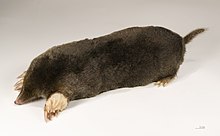European mole
This article has multiple issues. Please help improve it or discuss these issues on the talk page. (Learn how and when to remove these template messages)
|
| European mole Ma
| |
|---|---|

| |
| Scientific classification | |
| Domain: | Eukaryota |
| Kingdom: | Animalia |
| Phylum: | Chordata |
| Class: | Mammalia |
| Order: | Eulipotyphla |
| Family: | Talpidae |
| Genus: | Talpa |
| Species: | T. europaea
|
| Binomial name | |
| Talpa europaea | |

| |
| European mole range | |

The European mole (Talpa europaea) is a mammal of the order Eulipotyphla. It is also known as the common mole and the northern mole.[3]
This
Taxonomy
The Aquitanian mole (T. aquitania) was formerly considered conspecific, but was described as a distinct species in 2017.
Distribution
The European mole has a wide range throughout Europe and westernmost Asia, being found as far north as the United Kingdom and southern Scandinavia, as far south as northern Greece, and as far east as western Siberia. It is the only mole species in most of this range. The Loire River in France was thought to form the western barrier to the species' range, separating it from the Aquitanian mole, but studies indicate that while this is largely true, it is not a strict barrier, as member of either species have been found on opposite sides of the river, likely making them sympatric in at least some places.[5]
Description

The European mole has a cylindrical body and is 11 to 16 cm (4+1⁄2 to 6+1⁄2 in) long, weighing 70 to 130 g (2+1⁄2 to 4+1⁄2 oz).[6] Females are typically smaller than males. The eyes are small and hidden behind fur, while the ears are just small ridges in the skin. The fur is usually dark grey, but the actual range of colors is larger, as due to the subterranean habits there is no disadvantage in having off-colored fur. European moles with white, light grey, tan, taupe, and black fur have all been reported.[citation needed]
Habitat
While moles are typically found in tunnel systems, the European mole is not exclusively an underground dweller. In the spring and early summer when the young moles leave their mothers' burrows they must find new territories. This forces them to leave their burrows and they can either make new tunnel systems or enter existing systems. In the summer time, however, they are likely to burrow much more superficially. The superficial burrowing could be due in part to the soil that is much harder, which makes burrowing a greater challenge.[7]
T. europaea have also been found to spend a lot of time at the sides of drainage lines and streams but do not inhabit flooded or dry soils. However, dry areas do become important when their normal habitats become flooded. Factors such as the type of soil, vegetation present, and altitude have no effect on the areas that moles choose to inhabit. The one factor that does greatly influence the mole population in a specific area is the abundance of earthworms.[8] In suitable urban greenspace, an area of 10 hectares is required for population persistence, and the number of mole territories increases with available habitat.[9]
Reproduction
The European mole has a relatively short
Feeding habits
One common belief about European moles is that they typically consume their own weight in food every 24 hours, but this is an exaggeration. Studies have been performed that show European moles eat about half of their body weight in food each day. When in captivity, European moles will eat a wide variety of food items, including liver, mice, mealworms, shrews and maggots. However, they tend to prefer earthworms over all other options.[7] In areas without as many earthworms, insects are the main dietary constituent.[11] Moles eat both larval and adult insects.[11]
Vision
Due to the subterranean nature of this mole, there is an anatomical regression of its eyes at several organizational levels. Its eye has a
- The receptors are short along the radial axis
- The inner and outer segments are similar in length
- The outer segments appear to be significantly degenerated
Studies have shown that T. europaea does have
Hearing
In mammals, the cues for hearing are usually based on inter-aural intensity differences, which occur as a result of the diffraction of a progressive
Skeletal development
In Talpa europaea, there are several unique changes in ossification sequence in the
After a European mole is born and begins to develop, it will begin to crawl around and dig. As a result of the constant digging action, elements of the forelimb that are associated with those movements will begin to ossify. Some elements in the hands of Talpa europaea, formally described as distal
Dentition
The variance of
The Roman mole (
-
Molehills
-
Portrait
-
Skeleton
-
Analbino
See also
- Nova virus which was first isolated in European moles
- Mole (animal) for more general information on moles
References
- OCLC 62265494.
- . Retrieved 12 November 2021.
- ^ Talpa europaea, nomen.at
- ^ Mukherjee, Sarah (25 January 2008). "Searching for nature's tunnellers". BBC News. Retrieved 4 May 2010.
- S2CID 238260731.
- ^ Species fact sheet: Mole (Talpa eureopaea), The Mammal Society
- ^ S2CID 45094066.
- S2CID 21284497.
- PMID 32630423.
- .
- ^ a b Sondergaard, E. (2006). "Talpa europaea European Mole". Animal Diversity Web. Retrieved October 14, 2022.
- PMID 18484862.
- PMID 7166696.
- S2CID 28816066.
- ^ Cleef-Roders, J.T.; van den Hoek Ostende, L.W. (2001). "Dental morphology of Talpa europaea and Talpa occidentalis (Mammalia: Insectivora) with a discussion of fossil Talpa in the Pleistocene of Europe". Zoologische Mededelingen. 75: 51–68.
External links
 Media related to Talpa europaea at Wikimedia Commons
Media related to Talpa europaea at Wikimedia Commons





